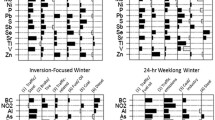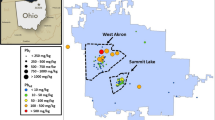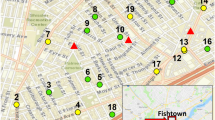Abstract
Heavy metal contamination in urban environments, particularly lead (Pb) pollution, is a health hazard both to humans and ecological systems. Despite wide recognition of urban metal pollution in many cities, there is still relatively limited research regarding heavy metal distribution and transport at the household-scale between soils and indoor dusts—the most important scale for actual human interaction and exposure. Thus, using community-scientist-generated samples in Indianapolis, IN (USA), we applied bulk chemistry, Pb isotopes, and scanning electron microscopy (SEM) to illustrate how detailed analytical techniques can aid in interpretation of Pb pollution distribution at the household-scale. Our techniques provide definitive evidence for Pb paint sourcing in some homes, while others may be polluted with Pb from past industrial/vehicular sources. SEM revealed anthropogenic particles suggestive of Pb paint and the widespread occurrence of Fe-rich metal anthropogenic spherules across all homes, indicative of pollutant transport processes. The variability of Pb pollution at the household scale evident in just four homes is a testament to the heterogeneity and complexity of urban pollution. Future urban pollution research efforts would do well to utilize these more detailed analytical methods on community-sourced samples to gain better insight into where the Pb came from and how it currently exists in the environment. However, these methods should be applied after large-scale pollution screening techniques such as portable X-ray fluorescence (XRF), with more detailed analytical techniques focused on areas where bulk chemistry alone cannot pinpoint dominant pollution mechanisms and where community scientists can also give important metadata to support geochemical interpretations.


Similar content being viewed by others
Data availability
All data and materials are included in the manuscript and supplementary documentation.
References
Adgate J, Rhoads G, Lioy P (1998) The use of isotope ratios to apportion sources of lead in Jersey City, NJ, house dust wipe samples. Sci Total Environ 221(2–3):171–180. https://doi.org/10.1016/S0048-9697(98)00282-4
Ayuso RA, Foley NK (2020) Surface topography, mineralogy, and Pb isotope survey of wheel weights and solder: source of metal contaminants of roadways and water systems. J Geochem Explor 212:106493. https://doi.org/10.1016/j.gexplo.2020.106493
Barnes M, McLeod CL, Chappell C, Faraci O, Gibson B, Krekeler MPS (2020) Characterizing the geogenic background of the Midwest: a detailed mineralogical and geochemical investigation of a glacial till in Southwestern Ohio. Environ Earth Sci 79(6):159. https://doi.org/10.1007/s12665-020-8890-z
Betts KS (2012) CDC updates guidelines for children’s lead exposure. Environ Health Perspect 120(7). https://doi.org/10.1289/ehp.120-a268
Deniel C, Pin C (2001) Single-stage method for the simultaneous isolation of lead and strontium from silicate samples for isotopic measurements. Anal Chim Acta 426(1):95–103. https://doi.org/10.1016/S0003-2670(00)01185-5
Dietrich M, Krekeler MPS, Kousehlar M, Widom E (2021) Quantification of Pb pollution sources in complex urban environments through a multi-source isotope mixing model based on Pb isotopes in lichens and road sediment. Environ Pollut 288:117815. https://doi.org/10.1016/j.envpol.2021.117815
Dietrich M, Shukle JT, Krekeler MPS, Wood LR, Filippelli GM (2022) Using community science to better understand lead exposure risks. GeoHealth 6(2):e2021GH000525. https://doi.org/10.1029/2021GH000525
Dietrich M, Wolfe A, Burke M, Krekeler MPS (2019) The first pollution investigation of road sediment in Gary, Indiana: anthropogenic metals and possible health implications for a socioeconomically disadvantaged area. Environ Int 128:175–192. https://doi.org/10.1016/j.envint.2019.04.042
Egendorf SP, Gailey AD, Schachter AE, Mielke HW (2020) Soil toxicants that potentially affect children’s health. Curr Probl Pediatr Adolesc Health Care 50(1):100741. https://doi.org/10.1016/j.cppeds.2019.100741
Filippelli GM, Adamic J, Nichols D, Shukle J, Frix E (2018) Mapping the urban lead exposome: a detailed analysis of soil metal concentrations at the household scale using citizen science. Int J Environ Res Public Health 15(7):1531. https://doi.org/10.3390/ijerph15071531
Gaberšek M, Gosar M (2021) Towards a holistic approach to the geochemistry of solid inorganic particles in the urban environment. Sci Total Environ 763:144214. https://doi.org/10.1016/j.scitotenv.2020.144214
Galer SJG, Abouchami W (1998) Practical application of lead triple spiking for correction of instrumental mass discrimination. Mineral Mag 62A(1):491–492. https://doi.org/10.1180/minmag.1998.62A.1.260
Gillings MM, Fry KL, Morrison AL, Taylor MP (2022) Spatial distribution and composition of mine dispersed trace metals in residential soil and house dust: implications for exposure assessment and human health. Environ Pollut 293:118462. https://doi.org/10.1016/j.envpol.2021.118462
Hayhow C, Brabander D, Jim R, Lively M, Filippelli GM (2021) Addressing the need for just GeoHealth engagement: evolving models for actionable research that transform communities. GeoHealth. https://doi.org/10.1029/2021GH000496
Herngren L, Goonetilleke A, Ayoko GA (2006) Analysis of heavy metals in road-deposited sediments. Anal Chim Acta 571(2):270–278. https://doi.org/10.1016/j.aca.2006.04.064
Jaeger RJ, Weiss AL, Manton WI (1998) Isotopic ratio analysis in residential lead-based paint and associated surficial dust. J Toxicol Clin Toxicol 36(7):691–703. https://doi.org/10.3109/15563659809162617
Kelepertzis E, Argyraki A, Chrastný V, Botsou F, Skordas K, Komárek M, Fouskas A (2020) Metal(loid) and isotopic tracing of Pb in soils, road and house dusts from the industrial area of Volos (central Greece). Sci Total Environ 725:138300. https://doi.org/10.1016/j.scitotenv.2020.138300
Kelepertzis E, Chrastný V, Botsou F, Sigala E, Kypritidou Z, Komárek M, Skordas K, Argyraki A (2021) Tracing the sources of bioaccessible metal(loid)s in urban environments: a multidisciplinary approach. Sci Total Environ 771:144827. https://doi.org/10.1016/j.scitotenv.2020.144827
Kousehlar M, Widom E (2020) Identifying the sources of air pollution in an urban-industrial setting by lichen biomonitoring—a multi-tracer approach. Appl Geochem 121:104695. https://doi.org/10.1016/j.apgeochem.2020.104695
Laidlaw MAS, Filippelli GM (2008) Resuspension of urban soils as a persistent source of lead poisoning in children: a review and new directions. Appl Geochem 23(8):2021–2039. https://doi.org/10.1016/j.apgeochem.2008.05.009
Miler M, Gosar M (2019) Assessment of contribution of metal pollution sources to attic and household dust in Pb-polluted area. Indoor Air 29(3):487–498. https://doi.org/10.1111/ina.12548
Obeng-Gyasi E, Roostaei J, Gibson JM (2021) Lead distribution in urban soil in a medium-sized city: household-scale analysis. Environ Sci Technol 55(6):3696–3705. https://doi.org/10.1021/acs.est.0c07317
Rader ST, Gaschnig RM, Newby SM, Bebout GE, Mirakian MJ, Owens JD (2021) Thallium behavior during high-pressure metamorphism in the Western Alps, Europe. Chem Geol 579:120349. https://doi.org/10.1016/j.chemgeo.2021.120349
Resongles E, Dietze V, Green DC, Harrison RM, Ochoa-Gonzalez R, Tremper AH, Weiss DJ (2021) Strong evidence for the continued contribution of lead deposited during the 20th century to the atmospheric environment in London of today. Proc Natl Acad Sci U.S.A 118(26). https://doi.org/10.1073/pnas.2102791118
Ringwald P, Chapin C, Iceman C, Tighe ME, Sisk M, Peaslee GF, Peller J, Wells EM (2021) Characterization and within-site variation of environmental metal concentrations around a contaminated site using a community-engaged approach. Chemosphere 272:129915. https://doi.org/10.1016/j.chemosphere.2021.129915
Smith DB, Cannon WF, Woodruff LG, Solano F, Kilburn JE, Fey DL, (2013) Geochemical and mineralogical data for soils of the conterminous United States: U.S. Geological Survey Data Series 801, 19 p., https://pubs.usgs.gov/ds/801/
Sutherland RA, Day JP, Bussen JO (2003) Lead concentrations, isotope ratios, and source apportionment in road deposited sediments, Honolulu, Oahu, Hawaii. Water Air Soil Pollut 142:165–186
Tansel B, Rafiuddin S (2016) Heavy metal content in relation to particle size and organic content of surficial sediments in Miami River and transport potential. Int J Sedim Res 31(4):324–329. https://doi.org/10.1016/j.ijsrc.2016.05.004
Thibodeau AM, Killick DJ, Ruiz J, Chesley JT, Deagan K, Cruxent JM, Lyman W (2007) The strange case of the earliest silver extraction by European colonists in the New World. Proc Natl Acad Sci 104(9):3663–3666. https://doi.org/10.1073/pnas.0607297104
Wade AM, Richter DD, Craft CB, Bao NY, Heine PR, Osteen MC, Tan KG (2021) Urban-soil pedogenesis drives contrasting legacies of lead from paint and gasoline in city soil. Environ Sci Technol 55(12):7981–7989. https://doi.org/10.1021/acs.est.1c00546
Wang Z, Dwyer GS, Coleman DS, Vengosh A (2019) Lead isotopes as a new tracer for detecting coal fly ash in the environment. Environ Sci Technol Lett 6(12):714–719. https://doi.org/10.1021/acs.estlett.9b00512
Wang Z, Wade AM, Richter DD, Stapleton HM, Kaste JM, Vengosh A (2021) Legacy of anthropogenic lead in urban soils: co-occurrence with metal(loids) and fallout radionuclides, isotopic fingerprinting, and in vitro bioaccessibility. Sci Total Environ 151276. https://doi.org/10.1016/j.scitotenv.2021.151276
Watson GP, Martin NF, Grant ZB, Batka SC, Margenot AJ (2022) Soil lead distribution in Chicago, USA. Geoderma Reg 28:e00480. https://doi.org/10.1016/j.geodrs.2021.e00480
Acknowledgements
The authors are deeply thankful to the households that supplied samples for this work and the lab techs who helped with initial sampling processing. Special thanks to Miguel Cruz for help with SEM instrumentation, Jason Kelly with help providing the samples, the two anonymous reviewers for their insightful comments, and Leah Wood and John Shukle for helpful comments on an earlier version of the manuscript.
Funding
The Anthropocene Network is supported by the Environmental Resilience Institute, funded by Indiana University’s Prepared for Environmental Change Grand Challenge Initiative. Partial support for this work was provided by NSF-EAR-PF Award #2052589 to M.D.
Author information
Authors and Affiliations
Contributions
Matthew Dietrich: conceptualization, funding acquisition, investigation, methodology, visualization, writing—original draft, data curation. Shelby T. Rader: methodology, writing—review and editing. Gabriel M. Filippelli: resources, supervision, writing—review and editing.
Corresponding author
Ethics declarations
Ethical approval
“Not applicable”
Consent to participate
“Not applicable”
Consent to publish
All authors agree to publish the manuscript in its present form.
Competing interests
The authors declare no competing interests.
Additional information
Responsible Editor: Philippe Garrigues
Publisher's note
Springer Nature remains neutral with regard to jurisdictional claims in published maps and institutional affiliations.
Supplementary Information
Below is the link to the electronic supplementary material.
Rights and permissions
Springer Nature or its licensor holds exclusive rights to this article under a publishing agreement with the author(s) or other rightsholder(s); author self-archiving of the accepted manuscript version of this article is solely governed by the terms of such publishing agreement and applicable law.
About this article
Cite this article
Dietrich, M., Rader, S.T. & Filippelli, G.M. Using community science for detailed pollution research: a case-study approach in Indianapolis, IN, USA. Environ Sci Pollut Res 30, 4269–4277 (2023). https://doi.org/10.1007/s11356-022-22561-4
Received:
Accepted:
Published:
Issue Date:
DOI: https://doi.org/10.1007/s11356-022-22561-4




